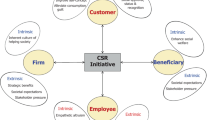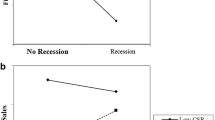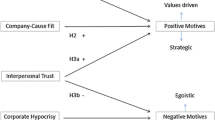Abstract
Corporate Social Responsibility (CSR) programs are increasingly popular corporate marketing strategies. This paper argues that CSR programs can fall along a continuum between two endpoints: Institutionalized programs and Promotional programs. This classification is based on an exploratory study examining the variance of four responses from the consumer stakeholder group toward these two categories of CSR. Institutionalized CSR programs are argued to be most effective at increasing customer loyalty, enhancing attitude toward the company, and decreasing consumer skepticism. Promotional CSR programs are argued to be more effective at generating purchase intent. Ethical and managerial implications of these preliminary findings are discussed.
Similar content being viewed by others
References
Andreasan A. R. (1986) Profits for Nonprofits: Find a Corporate Partner. Harvard Business Review 74(6): 47–59
Andreasen A., Drumwright M. (2001) Alliances and Ethics in Social Marketing. In: Andreasen A. (eds) In Ethical Issues in Social Marketing. Georgetown University Press, Washington, DC
Argandona A. (1998) The Stakeholder Theory and the Common Good. Journal of Business Ethics 17(9/10): 1093–1102
Ashforth B. E.., Mael F. (1989) Social Identity Theory and the Organization. Academy of Management Review 14(1): 20–39
Barrett P. (1996) Pinnell Hired to Lift Shell Image. Marketing Dec.(12): 5
Bettencourt L. A. (1997) Customer Voluntary Performance: Customers as Partners in Service Delivery. Journal of Retailing 73(3): 383–406
Bombay, C.: 2003, ‚Danny Bear Sales Page’, http://www.bombaycompany.com, Accessed: December 17
Boush D. M., Kim C.-H., Khale L. R., Batra R. (1993) Cynicism and Conformity as Correlates of Trust in Product Information Sources. Journal of Current Issues and Research in Advertising 15(2): 71–79
Brenner, S. N., Cochran, P. L. (1991) The Stakeholder Theory of the Firm: Implications for Business and Society Theory and Research. International Association for Business and Society Proceedings, Vol. No. pp. 449–467
British, P. 2003: ‚Environment and Society’, http://www.bp.com, Accessed: December 16
Brown T. J., Dacin P. A. (1997) The Company and the Product: Corporate Associations and Consumer Product Responses. Journal of Marketing 61(1): 68–84
Carroll A. (1991) The Pyramid of Corporate Social Responsibility: Toward the Moral Management of Organizational Stakeholders. Business Horizons 34: 39–48
Carroll A. (1999) Corporate Social Responsibility: Evolution of a Definitional Construct. Business and Society 38(3): 268–295
Carroll A. B. (1979) A Three-Dimensional Conceptual Model of Corporate Social Performance. Academy of Management Review 4(4): 497–505
Clarkson M. E. (1995) A Stakeholder Framework for Analyzing and Evaluating Corporate Social Performance. Academy of Management Review 20(1): 92–118
Cragg W. (2002) Business Ethics and Stakeholder Theory. Journal of Business Ethics 12(2): 113–142
Creyer E. H., Ross W. T. (1997) The Influence of Firm Behavior on Purchase Intention: Do Consumers Really Care About Business Ethics? Journal of Consumer Marketing 14(6): 421–432
Davis K., Blomstrom R. L. (1975) Business and Society: Environment and Responsibility. McGraw-Hill, New York
Day G. S. (1969) A Two-Dimensional Concept of Brand Loyalty. Journal of Advertising Research 9(September): 29–35
Dick A. S., Basu K. (1994) Customer Loyalty: Toward an Integrated Conceptual Framework. Journal of the Academy of Marketing Science 22(Winter): 99–113
Donaldson T., Preston L. E. (1995) The Stakeholder Theory of the Corporation: Concepts, Evidence, and Implications. Academy of Management Review 20: 64–91
Drumwright M. E. (1996) Company Advertising with a Social Dimension: The Role of Non-Economic Criteria. Journal of Marketing 60(4): 71–87
Duffy D. L. (2003) Internal and External Factors Which Affect Customer Loyalty. Journal of Consumer Marketing 20(5): 480–485
Ellen P. S., Mohr L. A., Webb D. J. (2000) Charitable Programs and the Retailer: Do They Mix? Journal of Retailing 76(3): 393–406
Ellen, P. S., L. A. Mohr, and D. J. Webb: 2003, ‘Pure or Mixed Motives: Consumer Attributions About Corporate Social Responsibility’, Working Paper, Georgia State University, Vol. No.
Ferrell O. C. (2004) Business Ethics and Customer Stakeholders. The Academy of Management Executive 18(2): 126–129
Fombrun C., Shanley M. (1990) What’s in a Name? Reputation Building and Corporate Strategy. Academy of Management Journal 33(2): 233–258
Fombrun C. J. (1996) Reputation: Realizing Value from the Corporate Image. Harvard Business School Press, Boston, MA
Freeman R. E. (1984) Strategic Management: A Stakeholder Approach. Pitman Publishing Inc., Marshfield, MA
Frost F., Matthews B., Evans M. (1999) Responses to General Inquiries Via the Internet: Targeting the Organizational Decision Makers. Journal of Targeting, Measurement and Analysis for Marketing 7(4): 374–386
Goodpaster K. E. (1991) Business Ethics and Stakeholder Analysis. Business Ethics Quarterly 1(1): 53–74
Griffin J. J., Mahon J. F. (1997) The Corporate Social Performance and Corporate Financial Performance Debate: Twenty Five Years of Incomparable Results. Business and Society 36: 5–31
Harvey B., Schaefer A. (2001) Managing Relationships with Environmental Stakeholders: A Study of U. K. Water and Electricity Utilities. Journal of Business Ethics 30(3): 243–260
Hellier P. K., Geursen G. M., Carr R. A., Rickard J. A. (2003) Customer Repuchase Intention: A General Structural Equation Model. European Journal of Marketing 37(11–12): 1762–1800
Hem L. E., Iversen N. M. (2003) Transfer of Brand Equity in Brand Extensions: The Importance of Brand Loyalty. Advances in Consumer Research 30: 72–79
Hemphill T. A. (1997) Legislating Corporate Social Responsibility. Business Horizons 40(2): 53–59
Hogg M. A., Abrams D. (eds) (1988) Social Identifications: A Social Psychology of Intergroup Relations and Group Processes. Routledge, New York
Ilieva J., Baron S., Healey N. M. (2002) Online Surveys in Marketing Research: Pros and Cons. International Journal of Market Research 44(3): 361–382
Jacoby J., Chestnut R. W. (1978) Brand Loyalty Measurement and Management. John Wiley & Sons., New York
Jacoby J., Kyner D. B. (1973) Brand Loyalty Versus Repeat Purchase Behavior. Journal of Marketing Research 10(February): 1–9
Jawahar I. M., McLaughlin G. L. (2001) Toward a Descriptive Stakeholder Theory: An Organizational Life Cycle Approach. Academy of Management Review 26(3): 397–415
Jones T. M. (1994) Essay on Toronto Conference. Business and Society 33(1): 98–101
Jones T. M., Wicks A. C. (1999) Convergent Stakeholder Theory. The Academy of Management Review 24(2): 206–221
Kantner D. L., Mirvis P. H. (1989) Thy Cynical Americans: Living and Working in an Age of Discontent and Disillusion. Jossey-Bass Publishers, San Francisco
Kent R., Lee M. (1999) Using the Internet for Market Research: A Study of Private Trading on the Internet. Journal of the Market Research Society 41(4): 377–385
KLD, D. (2003) “KLD Socrates”, http://www.kld. com, Accessed: December 17
Kotler P. (1972) A Generic Concept of Marketing. Journal of Marketing 36(2): 45–54
Kotler P. (1984) Marketing Management: Analysis, Planning and Control. Prentice-Hall, Englewood Cliffs, NJ
Kotler P., Levy S. (1969) Broadening the Concept of Marketing. Journal of Marketing 23(1): 10–15
Kroll C. (1996) Consumers Note Marketers’ Good Causes: Roper. Advertising Age 67(46): 51
Lockett A., Blackman I. (2004) Conducting Market Research Using the Internet: The Case of Xenon Laboratories. The Journal of Business and Industrial Management 19(3): 178–187
Maignan I., Farrell O. C. (2004) Corporate Social Responsibility and Marketing: An Integrative Framework. Journal of the Academy of Marketing Science 32(1): 3–19
McAlexander J. H., Kim S. K., Roberts S. D. (2003) Loyalty: The Influence of Satisfaction and Brand Community Integration. Journal of Marketing Theory and Practice 11(4): 1–10
McDonald H., Adam S. (2003) A Comparison of Online and Postal Data Collection Methods in Marketing Research. Marketing Intelligence and Planning 21(2): 85–95
McWilliams A., Siegel D. (2001) Corporate Social Responsibility: A Theory of the Firm Perspective. Academy of Management Review 26: 117–127
Miller B. A. (2002) Social Initiatives Can Boost Loyalty. Marketing News 36(21): 14–16
Mitchell R. K., Agle B. R., Wood D. J. (1997) Toward a Theory of Stakeholder Identification and Salience: Defining the Principle of Who and What Really Counts. Academy of Management Review 22(4): 853–887
Moore D. J., Harris W. D., Chen H. C. (1995) Affect Intensity: An Individual Difference Response to Advertising Appeals. Journal of Consumer Research 22(September): 154–164
Obermiller C., Spangenberg E. (2001) Development of a Scale to Measure Consumer Skepticism toward Advertising. Journal of Consumer Psychology 7(2): 159–186
Oliver R. L. (1997) Satisfaction: A Behavioral Perspective on the Consumer. Irwin/McGraw-Hill, New York
Oliver, R. L. 1999: ‚Whence Consumer Loyalty?’ Journal of Marketing, 63(Special Issue 1999), 33–44
Petty R. E., Unnava R. H., Strathman A. J. (1991) Theories of Attitude Change. In: Robertson, Kassarjian (eds) In Handbook of Consumer Behavior. Prentice Hall, New Jersey
Petty R. E., Wegener D. T., Fabrigar L. R. (1997) Attitudes and Attitude Change. Annual Review of Psychology 48: 609–647
Post F. R. (2003) A Response to “the Social Responsibility of Corporate Management: A Classical Critique”. Mid-American Journal of Business 18(1): 25–35
Reichheld F. F. (1996) The Loyalty Effect. Harvard Business School Press, Boston, MA
Reichheld F. F., Sasser W. E. (1990) Zero Defections: Quality Comes to Services. Harvard Business Review 68(September/October): 105–111
Rodgers W., Gago S. (2004) Stakeholder Influence on Corporate Strategies over Time. Journal of Business Ethics 13(6): 349–363
Ross J. K., Patterson L. T., Stutts M. A. (1992) Consumer Perceptions of Organizations That Use Cause Related Marketing. Journal of the Academy of Marketing Science 20(1): 93–97
Ross J. K., Stutts M. A., Patterson L. T. (1990–1991) Tactical Considerations for the Effectiveness of Cause Related Marketing. The Journal of Applied Business Research 7(2): 58–65
Ruf B. M., Muralidhar K., Brown R. M., Janney J. J., Paul K. (2001) An Empirical Investigation of the Relationship between Change in Corporate Social Performance and Financial Performance: A Stakeholder Theory Perspective. Journal of Business Ethics 32(2): 143–156
Santoro, E.: 1997 ‘Community Involvement Good for Companies’, Fund-Raising Management, 27(12), 9
Schaefer A., Dillman D. A. (1998) Development of a Standard Email Methodology: Results of an Experiment. Public Opinion Quarterly 62(3): 378–397
Sen S., Bhattacharya C. B. (2001) Does Doing Good Always Lead to Doing Better? Consumer Reactions to Corporate Social Responsibility. Journal of Marketing Research 38(May): 225–243
Simon F. L. (1995) Global Corporate Philanthropy: A Strategic Framework. International Marketing Review 12(4): 20–38
Simpson W. G., Kohers T. (2002) The Link between Corporate Social and Financial Performance: Evidence from the Banking Industry. Journal of Business Ethics 35: 97–109
Smith G., Stodghill R. (1994) Are Good Causes Good Marketing? Business Week 3363: 64–66
Tajfel H. (1972) Social Categorization. English Manuscript of “La Categorization Sociale”, in S. Moscovici (ed.), In Introduction a La Psychologie Sociale (Larousse, Paris
Tajfel H. (1978) Social Categorization, Social Identity and Social Comparison. In: Tajfel H. (ed.) Differentiation between Social Groups. Academic Press, New York
Tajfel H., Turner J. C. (1985) The Social Identity Theory of Intergroup Behavior. In: Worchel S., Austin W. G. (eds) Psychology of Intergroup Relations. Nelson-Hall Publishers, Chicago
Tellis G. J. (1988) Advertising Exposure, Loyalty, and Brand Purchase: A Two-Stage Model of Choice. Journal of Marketing Research 25(May): 134–144
Turban D. B., Greening D. W. (1997) Corporate Social Performance and Organizational Attractiveness to Prospective Employees. Academy of Management Journal 40(3): 658–672
Turner J. C. (1975) Social Comparison and Social Identity: Some Prospects for Intergroup Behavior. European Journal of Social Psychology 5(1): 5–34
Turner J. C. (1985) Social Categorization and the Self-Concept: A Social Cognitive Theory of Group Behavior. In: Lawler E. J. (ed.) Advances in Group Processes. JAI Press, Greenwich, CT
Ullmann A. (1985) Data in Search of a Theory: A Critical Examination of the Relationship among Social Performance, Social Disclosure and Economic Performance. Academy of Management Review 10(3): 540–577
Varadarajan P. R., Menon A. (1988) Cause Related Marketing: A Co-Alignment of Marketing Strategy and Corporate Philanthropy. Journal of Marketing 52(3): 58–74
Webb D. J., Mohr L. A. (1998) A Typology of Consumer Responses to Cause Related Marketing: From Skeptics to Socially Concerned. Journal of Public Policy and Marketing 17(2): 226–238
Weible R., Wallace J. (1998) Cyber Research: The Impact of the Internet on Data Collection. Market Research 10(3): 19–31
http://www.stonyfieldfarms.com (2004) “Stonyfield Farms Yogurt”, Accessed: August 7, 2004
Youjae Y., Suna L. (2004) What Influences the Relationship between Customer Satisfaction and Repurchase Intention? Investigating the Effects of Adjusted Expectations and Customer Loyalty. Psychology and Marketing 21(5): 351–373
Acknowledgements
The authors would like to thank MSI International, a full service marketing intelligence firm based near Philadelphia for the generous contribution of their survey programming and internet survey panel for data collection for this study.
Author information
Authors and Affiliations
Corresponding author
Additional information
Julie Pirsch, Ph.D., is an Assistant Professor of Marketing at Villanova University. She researches in the areas of cause-related marketing, corporate social responsibility, and new product development.
Shruti Gupta, Ph.D., is an Assistant Professor of Management at The Pennsylvania State University at Abington, in Abington, Pennsylvania. Dr. Gupta’s research interests lie in the area of corporate social responsibility, cause-related marketing, environmental consumerism, and social marketing issues.
Stacy Landreth, Ph.D., is an Assistant Professor of Marketing at the University of North Texas. She researches in the areas of cause-related marketing and social marketing alliances, as well as advertising source effects.
Appendices
APPEDNDIX A
Institutional CSR company description
Company R started in 1983 as a project of the Rural Education Center (a nonprofit agency) to help revitalize the struggling New England dairy industry and save the fast disappearing family farms.
Over the 20 years, this company has defined itself around its socially responsible agenda in the following way:
-
By using all natural organic ingredients (produced without the use of antibiotics, pesticides and fertilizers), no preservatives or artificial flavors or sweeteners.
-
Buying milk only from local family farmers rather than national dairy suppliers, and requires these farmers to use no antibiotics, growth hormones, pesticides or fertilizers.
-
Giving 10% of their profits to environmental causes, and has recycles all possible waste from manufacturing, including water and heat, and has decreased plant emissions by over 50%.
-
Reducing waste by:
-
switching to a lighter-weight plastic cup
-
replacing the plastic lid with a foil seal
-
giving the yogurt waste (in the manufacturing process) to local pig farmers to be used as hog feed instead of disposing it in a landfill or incinerator.
-
Building a workforce that reflects the local community by hiring a multi-ethnic group of workers and seeking out people from underrepresented segments of the population when hiring.
-
Reviewing their suppliers for fair labor practices, make sure suppliers offer a living wage to employees, and require basic health care services be provided.
APPENDIX B
Promotional CSR company description
Company W is part of a larger food products corporation that makes other products besides yogurt like breakfast cereal, snack foods, prepared meals, baked foods etc. The company’s CSR activities include:
-
Supporting Women’s Breast Cancer Cure by running a 4 month promotion every year called “More Lids for a Better Life.” This program has been offered for the past 2 years. For every yogurt cup lid that is returned to the company by the user, a 10 cent donation is made to a national Breast Cancer Foundation.
-
Providing information on women’s wellness – breast cancer, heart health, osteoporosis prevention and fitness – on its website.
Rights and permissions
About this article
Cite this article
Pirsch, J., Gupta, S. & Grau, S.L. A Framework for Understanding Corporate Social Responsibility Programs as a Continuum: An Exploratory Study. J Bus Ethics 70, 125–140 (2007). https://doi.org/10.1007/s10551-006-9100-y
Received:
Accepted:
Published:
Issue Date:
DOI: https://doi.org/10.1007/s10551-006-9100-y




